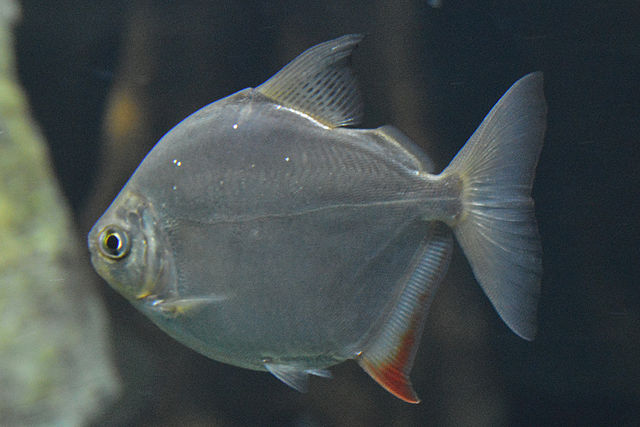The silver dollar (Metynnis hypsauchen) is a tropical freshwater fish, completely or partially silver in colour. As the name would suggest, the fish resembles a coin, as it’s round and flat; almost a diamond shape.

The ‘dollar’ is related to the red-bellied piranha (Pygocentrus nattereri) commonly known to tear the flesh off their prey alive, from small crustaceans to cattle. Despite this, the silver dollar is -thankfully- much more peaceful than its ferocious cousin, and ideal for keeping in a tropical freshwater set-up.
This is due to their tendency to completely strip aquatic plants bare, so while your fingers are safe, your Java fern isn’t.
NavigationSizeLifespanWater preferencesCareTank matesFeedingReproduction
Size
When a silver dollar (or shoal of silver dollars) are cared for properly, they can grow up to ten inches, but most stop growing between six to eight inches.
Lifespan
Silver dollars have an average lifespan of five to ten years – a relatively long life when compared with smaller fish like guppies, who will live for between a few months and five years if they are lucky. This means that they are a big commitment and if you are not sure if fish-keeping is for you, maybe start out with a few platies or guppies if you are unsure.
Silver dollars like to live in big shoals and are rather skittish. This can lead to them being prone to infections and they are more likely to live a shorter life.
Water preferences
They like the temperature between 24° and 29° C.
Care
Dollars are easy to care for. So as long as you have a tank big enough to house four or more fully grown dollars (if you plan on keeping them for that long, otherwise make sure that you have somebody ready to buy them off you or adopt them once they grow out of your tank) the maintenance that they require is relatively low.

Where possible, keep dollars in large groups. A group of six or seven is usually ideal for a large tank to help them feel safe and secure. They also prefer darker coloured substrates, but again, can become accustomed to lighter colours.
When it comes to plants, choose whether you would like a very densely planted tank, so that the dollars have a large choice of plant matter to nibble at, giving your other plants chance to regrow, or a tank with no live plants. If you choose the former, then pick hardy, quick growing plants like Amazon Sword or Anubis. If you choose the latter, choose plastic plants, rocks or ornaments to create hiding places, as dollars have been known to strip even silk plants.
Since there is so much conflicting advice about tropical fish care in general, I will leave the specifics, but make sure that you have an established tank, do regular water changes, and feed them appropriately, they require no additional care.
Tank mates
As a rule, if a fish can fit in another’s mouth, presume that it will be eaten, however I have successfully raised platy fry and guppy fry in my tropical aquarium with tetra, silver dollars, and scissortail rasboras.
Often, it is recommended to keep dollars with other large fish, simply for the aesthetic, like Bala sharks and catfishes, but they are equally as beautiful with shoals of tetra and are very peaceful. Generally, any other peaceful fish are fine to go with dollars.
Feeding
Silver dollars survive mostly on plant matter, and will feed on flakes, algae wafers – they go crazy for them, break them up and spread bits about the tank unless you want a fight! – cucumber, courgette, lettuce, and squash, but will also eat brine shrimp and bloodworm.
Silver dollars begin to reproduce at around one year old. The females drop eggs, they are a translucent yellow colour and are not sticky. They will not usually do any harm to their eggs, and they take approximately four to six days to mature. Once the juvenile begins to swim, they can be fed on crushed flake food, brine shrimp, and milled salad leaves, amongst other things.
Sources
http://www.petguide.com/breeds/fish/silver-dollar/
http://www.fishlore.com/Profiles-SilverDollar.htm
http://meethepet.com/silver-dollar-metynnis-argenteus/

